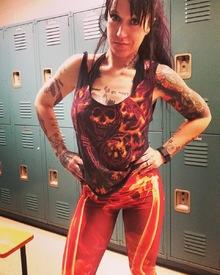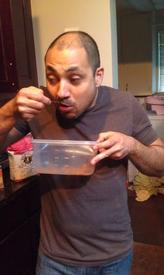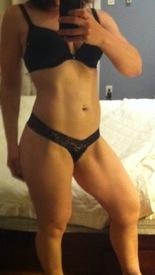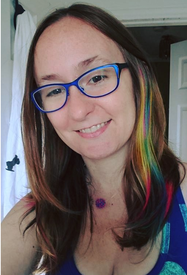Best way to measure body fat?

Oh_Cat
Posts: 59 Member
Hi all,
I was just looking for a little advice. I'm 25 years old, based in the UK and currently on huuuge fitness kick :blushing:
I'm obviously striving to lose fat, not muscle - so I circuit train, run, spin, lift weights and generally work out 6 days a week. Now that I'm starting to really feel a difference in my body (mostly my legs, but I swear there are some abs lurking somewhere too!) I'd love to measure my body fat and see if I'm having a positive effect on it.
So my question - what's the best way to measure body fat? Do I need to go find a personal trainer with those pinchy things? Are the scales a total waste of time? The machines you see in Boots / at gyms etc?
Would really appreciate any advice - thanks guys!
(Ps - feel free to add me - I log every day, have an open diary and I support my MFP pals 100%!)
I was just looking for a little advice. I'm 25 years old, based in the UK and currently on huuuge fitness kick :blushing:
I'm obviously striving to lose fat, not muscle - so I circuit train, run, spin, lift weights and generally work out 6 days a week. Now that I'm starting to really feel a difference in my body (mostly my legs, but I swear there are some abs lurking somewhere too!) I'd love to measure my body fat and see if I'm having a positive effect on it.
So my question - what's the best way to measure body fat? Do I need to go find a personal trainer with those pinchy things? Are the scales a total waste of time? The machines you see in Boots / at gyms etc?
Would really appreciate any advice - thanks guys!
(Ps - feel free to add me - I log every day, have an open diary and I support my MFP pals 100%!)
0
Replies
-
I have a handheld Omron Fat Loss Monitor and I think it is pretty accurate. It says I am around 17% body fat which seems to match up to those body comparison charts and what a fitness trainer eyeballed me around..0
-
I have a handheld Omron Fat Loss Monitor and I think it is pretty accurate. It says I am around 17% body fat which seems to match up to those body comparison charts and what a fitness trainer eyeballed me around..
Thanks, I'll check that out 0
0 -
I think the online calcs work pretty well with accurate measurements. I take wrist, forearm, neck, waist, and hip measurements. You've probably done this, but just in case you haven't, you can find a variety of BF calcs by just googling it. Plug in your measurements and you'll get a BF % that should be good +/- 2%
This also keeps me motivated when I don't see movement on the scale.0 -
I have used the following:
1. Fat2Fit iphone app (for body fat percentage).
2. Handheld body fat analyser (at Gym).
3. Omron scales (with body fat analyser). I recently bought this and planning to return because Fat2Fit app tells me pretty reasonable figures compared to omron scale.
Also, whatever technique that you use, just think that its just a ball park figure and just work out accordingly.0 -
Thanks so much everyone!
I'm going to see if my gym can do some kind of measurement for me. I like the idea of the handheld analysers (would rather something I can do in home, in private!) but a lot of the reviews say they can give vastly differing readings form one moment to the next... Will check out the online calcs too.
I guess it doesn't really matter how accurate my reading is, as long as it's going down 0
0 -
I have a handheld Omron Fat Loss Monitor and I think it is pretty accurate. It says I am around 17% body fat which seems to match up to those body comparison charts and what a fitness trainer eyeballed me around..
We use Omron Body Fat Monitors at work to train nurses how to measure body composition. They're good, although at first it does feel like you're putting your details into a machine so it can insult you to your face.
Like scales, it's best not to pick it up too frequently; in the short term you can convince yourself it's going the wrong way, when in the long term all might be fine.0 -
It's also important to remember to measure body fat under similar circumstances every time.
Body Fat Monitors send a pulse through your skin and measure how it conducts. Lean muscle conducts better than fat, but sweat in the skin can alter the reading. So make sure you're well rested when you take the reading to get the most accurate results.0 -
I use youw8 scales, as danblood put, consistency counts!
Don't know the old method, jump up and down in front of the mirror naked
Also take photos once a week 0
0 -
I also track progress with bodyfat. Weight is not the whole picture, and the scale can lie as badly as the man in the mirror.
You can check here for free: http://www.scientificpsychic.com/fitness/diet.html
I like this method, because it is easy to take and the results are consistant.
Some complain that it gives too high a ready.
SOLUTION: Subtract -5% and go with that number.
The bottom line is that we have something definitive to track progress.
This is it.
Good Luck!:flowerforyou:0 -
I use youw8 scales, as danblood put, consistency counts!
Don't know the old method, jump up and down in front of the mirror naked
Also take photos once a week
The scales are great and I would recommend them to anyone. They are so accurate and show how your body composition is changing. Nice to see.0 -
-
Best way: Hydrostatic water tank test or bod pod
Next best: caliper test administered by an experienced professional0 -
Best way: Hydrostatic water tank test or bod pod
Next best: caliper test administered by an experienced professional
This!!!0 -
Best way: Hydrostatic water tank test or bod pod
Next best: caliper test administered by an experienced professional
I don't know about bod pod being the best way
I would think a dexa is much more accurate0 -
I use Tanita Body Composition Scales and I recently allowed the trainee PT at the gym the opportunity to use calipers "pinching for fat" and it was interesting to see where I was lean and where fat was stored, not that I can do anything about where the fat is stored I can only do my best to lose fat deposits.
The caliper test and tanita were about the same.
Would love to afford a bod pod or hydro test. If any researchers want a volunteer in the UK, hint hint0 -
Best way: Hydrostatic water tank test or bod pod
Next best: caliper test administered by an experienced professional
I don't know about bod pod being the best way
I would think a dexa is much more accurate
There are quite a few potential problems with the accuracy of DEXA scans similar to the other methods which include the actual machine, the operator and water weight. The machines were initially developed for bone density testing, not BF testing.0 -
If you just want to figure out if you're losing body fat, you don't necessarily need the most accurate. It's easy to tell if you're getting slimmer and your weight is staying the same for example. And you could be losing body fat but as a ratio compared to the rest of you while you're losing weight it may remain the same.
Some ways to weigh:
Hydrostatic (Underwater) Weighing - This is the most accurate way of measuring since it doesn't predict body density. There is a error margin for residual volume (lung capacity). Remember, the density (mass/volume) of water changes with temperature (water becomes larger when it freezes into ice cubes for example).
density_body/density_water = density_body/(~1g/cm^3) = weight_body/(weight_body - weight_immersed)
Skin Fold Methods - This can change depending on who does it and what you're doing. A pair of calipers/callipers can be used to pinch standardized parts of the body such as your bicep and belly, determining the subcutaneous fat layer thickness. These sites are measured several times and averaged, and an average is taken of the averages to determine body fat percentage. The calculations some people use seem to vary and consist of body mass index rating scales so I will not list them here. Caliper readings can be done at a lot of local gyms. Demonstrations are available on YouTube. For accuracy, the same person has to accurately measure you the same way at the same point in your cycle and day. Even if you are being accurate the values can fluctuate between meals, activities, and hormones changes throughout time. But you will generally see what's happening to your body fat from month to month. If your eating habits, activity level, or time you have the reading done changes (especially if you're female), the values can change.
Weight Scales/Bioelectrical impedance analysis (BIA) - This functionality is built into many weight scales and other devices (such as Omron hand grippers) these days. The values can vary greatly, even if you have 2 of the same scale (according to my scale manual, but I tried a couple and they were the same). Scales that can do this are actually reading your electrical impedance, so it requires skin to metal contacts (this is why you do not receive a % value if you are wearing socks). These scales can figure out your total body water (TBW), which can help calculate LBM, BF and bone mass. Since this depends on your TBW, the values can vary greatly depending on if it's that time of the month, you're hydrated, your hot (related to damp skin), you're losing weight etc etc. It can also be inaccurate depending on where your carrying your fat. For example, if you carry your weight in the top half of your body and use a scale that sends the current through the bottom half. With that being said, I tried doing hand stands, standing, and balancing on different limbs and mine gave me the same value.
V=Voltage=IR=Current*Resistance=Current*|Impedance|^(Imaginary#*phase)=Complicated=you have as much equipment then me in your house.
Body Mass Index (BMI) - Your BF can be calculated from your BMI (sex=1 if male, 0 if female).
Child body fat % = (1.51*BMI) - (0.70 * Age) - (3.6 * sex) + 1.4
Adult body fat % = (1.20*BMI) + (0.23 * Age) - (10.8 * sex) - 5.4
Example (me): BF% = (1.20*18.8) + (0.23*29) - (10.8*0) - 5.4 = 23.83% fat
Anthropometric/Height and Circumference Methods - The U.S. Marine Corps and U.S. Army (Department of Defense) use this method along with Covert Bailey and fat2fit's body fat calculator. They make calculations based on mass, and the circumference of various body parts such as waist, hip, bicep, forearm and wrist.
U.S. Army (Department of Defense) Military BF Calculator: http://www.fat2fitradio.com/tools/mbf/
Covert Bailey BF Calculator: http://www.fat2fitradio.com/tools/cbbf/
Fat 2 Fit BF Calculator: http://www.fat2fitradio.com/tools/bf/0
This discussion has been closed.
Categories
- All Categories
- 1.4M Health, Wellness and Goals
- 395.6K Introduce Yourself
- 44.1K Getting Started
- 260.7K Health and Weight Loss
- 176.2K Food and Nutrition
- 47.5K Recipes
- 232.7K Fitness and Exercise
- 446 Sleep, Mindfulness and Overall Wellness
- 6.5K Goal: Maintaining Weight
- 8.6K Goal: Gaining Weight and Body Building
- 153.2K Motivation and Support
- 8.2K Challenges
- 1.3K Debate Club
- 96.4K Chit-Chat
- 2.5K Fun and Games
- 4.3K MyFitnessPal Information
- 16 News and Announcements
- 1.3K Feature Suggestions and Ideas
- 2.9K MyFitnessPal Tech Support Questions









